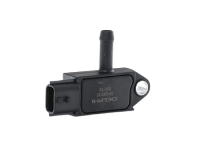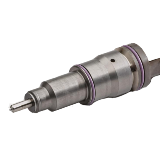Resource Highlights
In this article you will find about how a Diesel Particulate Filter (DPF) differential pressure sensor works, including; why a DPF differential pressure sensor fails, things to look out for and common fault codes.
A diesel particulate filter (DPF) differential pressure sensor measures exhaust backpressure and signals when the power-train control module (PCM) should begin a regeneration process to clear the filter of diesel particulate matter (DPM), or soot. The DPF differential pressure sensor plays an important role in keeping the DPF functioning properly. A clogged DPF is not only a costly repair, but it can have catastrophic consequences to your diesel engine as well. To understand how the DPF differential pressure sensor works, why it fails, and how to replace it when it does, let’s briefly discuss the DPF.

What is the DPF and how does it work?
As stringent emissions regulations increase to reduce emissions, diesel engines use an EGR valve to reduce NOx emissions and a DPF to remove soot from diesel exhaust. Installed near the beginning of the exhaust system, the wall flow design of the DPF traps on average 85% of the soot coming from the engine, and in certain conditions can even attain 100% efficiency. To keep the filter from clogging, the engine initiates a regeneration process by injecting fuel into the exhaust system. The injected fuel will raise the temperature of the DPF to 600 °C (or 1112°F) so the obstructing soot can burn off by converting it into ash. For some vehicles, PCM relies on data from the DPF differential pressure sensor to initiate the DPF regeneration process.
How does a DPF differential pressure sensor work?
The DPF differential pressure sensor is usually mounted in the engine compartment to protect it from heat. The sensor is connected to the engine control unit (ECU) by an electrical connector and connected to the DPF via two silicon hoses. One hose connects before (upstream) the DPF, the other connects after (downstream) the filter. By measuring and comparing the difference in pressure of the exhaust gas before and after the filter, the sensor can estimate the amount of DPM that is trapped in the filter and signal the PCM to start the DPF regeneration process.
Why do DPF differential pressure sensors fail?
As with any electrical sensor in an engine, wires to the ECU can be damaged from harsh vibrations or crack and melt from extreme heat. And just like the DPF, the sensor hoses can also become clogged from soot in the exhaust. When diesel particulate matter blocks one or both of these airways to the sensor, the sensor can no longer determine pressure changes accurately, which can result in catastrophic damage to the DPF and ultimately the engine.
What to look out for in a failing DPF differential pressure sensor
When the DPF differential pressure sensor stops signalling the PCM to regenerate, the DPF can become completely obstructed by contaminates and fail. Here are some signs that indicate the DPF is not regenerating properly due to the DPF sensor failing:
- Poor engine performance
- Poor fuel economy
- High engine temperatures
- High transmission temperatures
- An increase in black smoke (soot) from the exhaust
- Check engine light
When the DPF fails, exhaust gases can not be fully purged as backpressure pushes exhaust back into the combustion chamber causing DPM or soot to mix with the engine oil. Soot is abrasive and when mixed with oil, will cause premature wear to the engine bearings. The fuel that should be escaping through the exhaust during regeneration will also only partially burn. This leftover fuel will then wash away the protective oil film on internal engine components and cause catastrophic failure.
A DPF pressure sensor is vital to the longevity of the DPF, and if the DPF becomes completely obstructed, the regeneration process will not fix it. It will need to either be removed and professionally cleaned or replaced, both options on average costing thousands of dollars. Much more than the cost of diagnosing and replacing a faulty sensor before it’s too late.
Common fault codes
If your check engine light is turned on, here are the codes associated with a DPF sensor.
- P2452: Diesel Particulate Filter Pressure Sensor 'A' Circuit
- P2453: Diesel Particulate Filter Pressure Sensor A Circuit Range/Performance
- P2454: Diesel Particulate Filter Pressure Sensor “A” Circuit Low
- P2455: Diesel Particulate Filter Pressure Sensor A Circuit High
Note: An exhaust leak can cause these codes to set.
How to troubleshoot a DPF differential pressure sensor
When troubleshooting engine sensors, it is recommended to look for any signs of visible damage first. Check all connections, starting with the sensor electrical connector, and look for any damage such as cracking or melting. Any damaged wires will need to be replaced.
Next, inspect the hoses connected to the sensor. Again, look for any damage such as cracking or melting. If the hoses are damaged, they will need to be replaced and most likely rerouted so they are not damaged the same way again. If the hoses look to be in good physical condition, check for any blockage or clogs. If clogged, the hoses will need to be cleared or replaced.
If everything passes physical inspection, you can test the DPF differential pressure sensor using a multimeter set to 20V and a pressure gauge.
- With the battery on and engine off, connect the multimeter ground to the negative battery terminal and run a quick plausibility by checking the voltage of the battery. It should be around 12.6 volts.
- Consult the manufacturer’s service manual to identify the signal, ground, and 5-volt reference and back-probe the wires.
- Turn the ignition switch on without starting the engine. The multimeter should (typically) display a voltage between 4.5 to 5 volts for the 5-volt reference, a steady 0 volts for the ground wire, and between 0.5 and 4.5 volts for the signal wire. Consult OEM factory service information for the exact specs on your vehicle.
- Start the engine with the signal wire back-probed.
- Rev the engine and notice if there is a change in voltage. If not, move on to test the connecting hoses with a pressure gauge.
- With the engine still running, remove the hoses from the sensor.
- Using a pressure gauge, measure the pressure of both hoses. For sufficient accuracy, use an exhaust back pressure gauge that measures 0-15 PSI.
- Check the signal voltage again. The voltage should read a number between the pressure values of the hoses. For example, if the rear hose reads half PSI and the front hose reads 1 PSI, the voltage of the signal wire should read somewhere in the middle around .8 volts.
If your voltage differs greatly or the pressure values do not match the voltage reading, the DPF differential pressure sensor is faulty and will need to be replaced.














